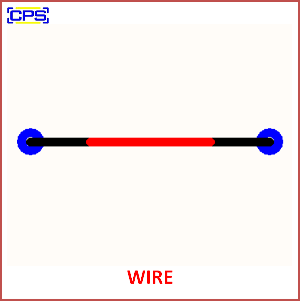A Wire is a thin, flexible strand or rod of metal used to conduct electricity or transmit signals. It is typically made of materials with good electrical conductivity, such as copper or aluminum, and is often insulated with a non-conductive material like plastic to prevent short circuits or electrical shock.

Key Features of a Wire:
- Conductor of Electricity:
- The primary function of a wire is to carry electrical current between components in a circuit. The metal core of the wire conducts electricity, while the insulation ensures safety and prevents accidental contact with live conductors.
- Material:
- Wires are usually made from materials that conduct electricity well, such as:
- Copper: Known for its excellent conductivity and flexibility.
- Aluminum: Lighter and more affordable, though less conductive than copper.
- Other metals may be used for specific applications, such as gold or silver in high-performance electronics.
- Wires are usually made from materials that conduct electricity well, such as:
- Insulation:
- Most wires are coated with an insulating layer made of materials like PVC (polyvinyl chloride), rubber, or Teflon. This insulation helps prevent electrical short circuits and protects people from electrical hazards.
- Gauge (Thickness):
- Wires come in different thicknesses, known as the gauge. A lower gauge number indicates a thicker wire, which can carry more current. The thickness affects the wire’s resistance, current-carrying capacity, and flexibility.
- Flexibility:
- Wires can be flexible or rigid. Flexible wires are often used for applications requiring movement, while rigid wires are used for stationary applications.
Types of Wires:
- Single-Strand Wire:
- Consists of a single solid metal conductor, providing good strength and durability. It is less flexible than multi-strand wire and is often used in applications where the wire remains stationary.
- Multi-Strand Wire:
- Made up of several smaller strands of wire twisted together. This type of wire is more flexible and is used in applications where the wire needs to bend or move.
- Coaxial Cable:
- A type of wire used for transmitting high-frequency signals, where the wire is made of an inner conductor, an insulating layer, a metallic shield, and an outer insulating layer.
- Twisted Pair Cable:
- Composed of two insulated wires twisted together to reduce electromagnetic interference. Commonly used in networking and telephone systems.
Applications of Wires:
- Electrical Wiring:
- Used in electrical circuits to connect components such as switches, outlets, lights, and appliances.
- Power Transmission:
- Wires are used in power lines to transmit electrical energy from power plants to homes, businesses, and industries.
- Communication:
- Wires and cables are used in telecommunications, including telephone lines, internet connections, and radio signals.
- Electronics:
- Wires connect various components on circuit boards, enabling the flow of current in electronic devices like computers, televisions, and mobile phones.
- Automotive:
- In cars and other vehicles, wires are used for the electrical systems, including lighting, ignition, and electronic control systems.
Advantages:
- Efficient Conductor: Wires made of conductive materials like copper or aluminum allow electricity to flow efficiently with minimal resistance.
- Versatile and Flexible: Wires can be adapted for various uses, including residential, commercial, and industrial applications.
- Easy Installation: Wires are easy to install and configure in both simple and complex systems.
Disadvantages:
- Risk of Short Circuits: Wires can cause short circuits if damaged, especially if their insulation is compromised.
- Corrosion: Some wires, especially those made of aluminum, can corrode over time, leading to degradation of their conductivity.
- Overloading: If wires are too thin for the amount of current they carry, they can overheat and pose a fire hazard.
